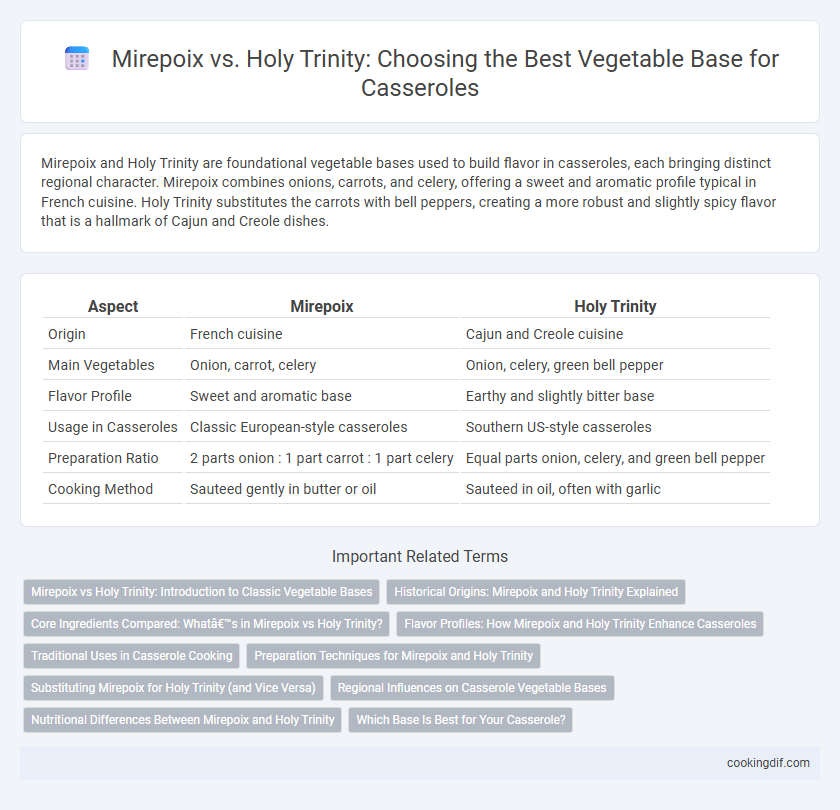Mirepoix and Holy Trinity are foundational vegetable bases used to build flavor in casseroles, each bringing distinct regional character. Mirepoix combines onions, carrots, and celery, offering a sweet and aromatic profile typical in French cuisine. Holy Trinity substitutes the carrots with bell peppers, creating a more robust and slightly spicy flavor that is a hallmark of Cajun and Creole dishes.
Table of Comparison
| Aspect | Mirepoix | Holy Trinity |
|---|---|---|
| Origin | French cuisine | Cajun and Creole cuisine |
| Main Vegetables | Onion, carrot, celery | Onion, celery, green bell pepper |
| Flavor Profile | Sweet and aromatic base | Earthy and slightly bitter base |
| Usage in Casseroles | Classic European-style casseroles | Southern US-style casseroles |
| Preparation Ratio | 2 parts onion : 1 part carrot : 1 part celery | Equal parts onion, celery, and green bell pepper |
| Cooking Method | Sauteed gently in butter or oil | Sauteed in oil, often with garlic |
Mirepoix vs Holy Trinity: Introduction to Classic Vegetable Bases
Mirepoix, a classic French vegetable base, combines diced onions, carrots, and celery to create a balanced, sweet, and aromatic foundation for casseroles and soups. The Holy Trinity, essential in Cajun and Creole cooking, replaces carrots with bell peppers alongside onions and celery, offering a savory and slightly spicy flavor profile. Both bases provide essential depth, but Mirepoix's sweetness contrasts with the Holy Trinity's bold, pepper-forward taste.
Historical Origins: Mirepoix and Holy Trinity Explained
Mirepoix, a foundational vegetable base in French cuisine, traditionally consists of diced onions, carrots, and celery sauteed slowly to release deep flavors, dating back to the 18th century. The Holy Trinity, essential in Cajun and Creole cooking, substitutes bell peppers for carrots, blending onions, celery, and green bell peppers to reflect Louisiana's regional agricultural produce and cultural influences. Both bases shape the flavor profiles of casseroles and stews, highlighting the historical and geographical roots of their respective culinary traditions.
Core Ingredients Compared: What’s in Mirepoix vs Holy Trinity?
Mirepoix traditionally consists of diced onions, carrots, and celery, forming the foundational vegetable base in French cuisine. The Holy Trinity, a staple in Cajun and Creole cooking, replaces carrots with bell peppers, combining onions, celery, and green bell peppers. Both blends enhance casseroles with aromatic depth, but their core ingredients cater to distinct regional flavors and cooking styles.
Flavor Profiles: How Mirepoix and Holy Trinity Enhance Casseroles
Mirepoix, a classic French vegetable base of onions, carrots, and celery, imparts a subtle sweetness and depth of flavor that enhances the richness of casseroles. The Holy Trinity, consisting of onions, green bell peppers, and celery, introduces a slightly sharper, earthier taste with a hint of bitterness, adding complexity to Creole and Cajun-style casseroles. Both bases create foundational aromatic layers, but Mirepoix leans towards a balanced, mellow profile while the Holy Trinity brings a vibrant, bold character to the dish.
Traditional Uses in Casserole Cooking
Mirepoix, a traditional French vegetable base of onions, carrots, and celery, provides a subtly sweet and aromatic foundation commonly used in classic casseroles like pot pies and beef stews. The Holy Trinity, combining onions, bell peppers, and celery, is essential in Cajun and Creole casseroles such as jambalaya and gumbo, delivering a robust and earthy flavor profile. Both bases enhance casseroles by layering flavors uniquely tied to their cultural origins, influencing the overall taste and authenticity of the dish.
Preparation Techniques for Mirepoix and Holy Trinity
Mirepoix, a classic French vegetable base, is prepared by finely dicing onions, carrots, and celery into uniform small cubes to ensure even cooking and flavor release during the long slow simmer of casseroles. The Holy Trinity, a staple in Cajun and Creole cuisine, involves chopping onions, bell peppers, and celery, typically into slightly larger pieces to maintain texture and provide a distinct flavor profile in dishes like jambalaya and gumbo casseroles. Both preparation techniques emphasize careful knife skills and consistent sizing to balance flavor development and texture in the final casserole.
Substituting Mirepoix for Holy Trinity (and Vice Versa)
Mirepoix, a classic French vegetable base composed of diced onions, carrots, and celery, can be substituted with the Cajun Holy Trinity--onions, bell peppers, and celery--for casseroles requiring a more robust, aromatic profile. When replacing Holy Trinity with mirepoix, the sweetness from carrots enhances depth, while mirepoix's milder flavor adjusts the dish toward a traditional French or Mediterranean style. Both bases provide essential flavor foundations, and choosing between them impacts the casserole's overall taste, texture, and regional authenticity.
Regional Influences on Casserole Vegetable Bases
Mirepoix, consisting of diced onions, carrots, and celery, is a classic French vegetable base commonly used in casseroles to impart a sweet and aromatic flavor profile. The Holy Trinity, made of onions, bell peppers, and celery, originates from Cajun and Creole cuisines in Louisiana, adding a distinctively spicy and savory dimension to regional casseroles. Regional influences shape the choice between Mirepoix and the Holy Trinity, reflecting local produce availability and traditional flavor preferences in casserole recipes.
Nutritional Differences Between Mirepoix and Holy Trinity
Mirepoix, consisting of onions, carrots, and celery, provides a rich source of vitamins A and C along with dietary fiber, supporting immune function and digestion. The Holy Trinity, made up of onions, bell peppers, and celery, offers higher vitamin C content and antioxidants from bell peppers, enhancing anti-inflammatory benefits. Both vegetable bases contribute essential nutrients to casseroles, but the Holy Trinity delivers a more potent boost in vitamin C and antioxidants compared to mirepoix's beta-carotene emphasis.
Which Base Is Best for Your Casserole?
Choosing between mirepoix and the Holy Trinity as a vegetable base for your casserole depends on your desired flavor profile and regional influence. Mirepoix, a classic French blend of onions, carrots, and celery, offers a subtle sweetness and depth, ideal for hearty, savory casseroles. The Holy Trinity, consisting of onions, bell peppers, and celery, delivers a vibrant, slightly spicy taste perfect for Cajun or Creole-inspired casseroles.
Mirepoix vs Holy Trinity for vegetable base Infographic

 cookingdif.com
cookingdif.com